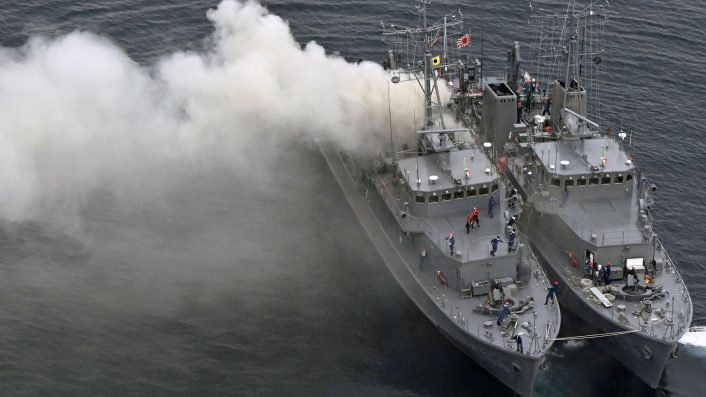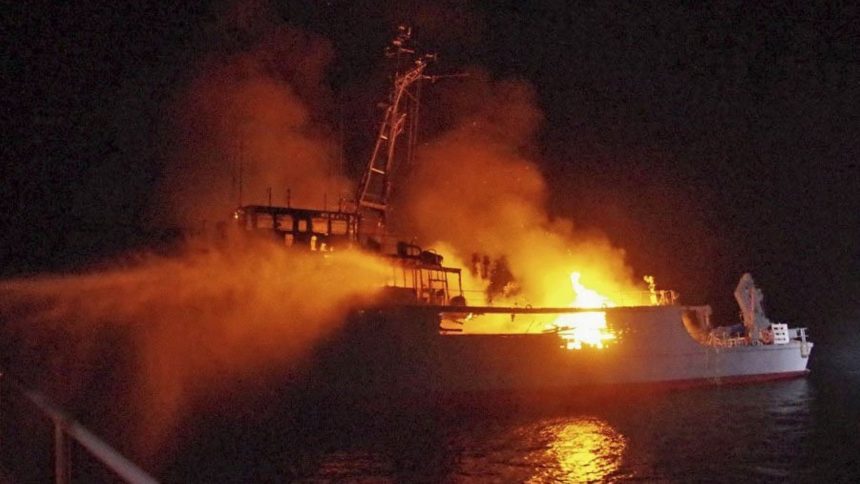A Sugashima-class mine clearance vessel, the JS Ukushima, experienced a fire in the engine room on the morning of Nov. 10 off Oshima island, near the Fukuoka Prefecture, while it was preparing for a drill with the U.S. Navy. The exercise was subsequently canceled.
In a tragic incident, one sailor of the JMSDF (Japan Maritime Self-Defense Force) is now missing after a minesweeper, the JS Ukushima, caught fire on Nov. 10, 2024, and later sank off the coast of the Fukuoka Prefecture, The Asahi Shimbun reported. The Sugashima-class mine clearance vessel, which was carrying a crew of 38 to 40, according to reports, experienced a fire in the engine room at around 9:40 am while some 2.5 km off the Oshima island during a training exercise.
The vessel immediately sent out a distress call to the JCG’s (Japan Coast Guard) 7th Regional Headquarters. JS Ukushima had left the Shimonoseki base in Yamaguchi Prefecture and was sailing to Kagoshima Prefecture for the drill with the U.S. Navy, Kyodo News said. The exercise was subsequently canceled following the mishap.
The missing crew member has been identified as 33-year-old Petty Officer 3rd Class Tatsunori Koga. Another JMSDF personnel is recuperating at a hospital, and both were assigned to the engine room. The incident is reminiscent of the fire onboard a U.S. Navy’s amphibious ship, the USS Bonhomie Richard, which was heavily damaged by a fire erupted onboard in July 2020.
The 54-meter-long minesweeper, with a displacement of 510 tons, was built with a wooden hull to resist magnetic mines.
‼️#NavalNews
Japanese Maritime Self-defence Force Sugashima-class minesweeper JS Ukushima (MSC-686) caught fire in waters off the country’s southwestern coast capsized and sank, according to the local coast guard office.
Source: https://t.co/tfRiYIP5bg pic.twitter.com/UR1nHAxX6A
— Saturnax 🇸🇰🇪🇺🇺🇦 (@Saturnax1) November 11, 2024
Rescue efforts
The inferno went on for nearly six to seven hours, with JCG vessels and another JMSDF minesweeper, the JS Toyoshima, joining the firefighting and rescue efforts. Japan’s NHK News posted a video on its X page, showing the minesweeper ablaze at 7 p.m. on Sunday. Another video showed the ship’s capsized bow just barely sticking above the water.
A set of images and a video by ‘OSINTdefender’ showed the Toyoshima and the Ukushima side by side, transfering survivors, with heavy and thick smoke billowing from the engine exhaust behind the bridge. This could suggest that the fire must have intensified after efforts were initially focused on the rescue, following the containment of the fire.
While the survivors were successfully evacuated to the Toyoshima, by midnight on Nov. 11, the fire was extinguished. By 8:30 a.m. the next morning, the Ukushima finally capsized and sank.
JMSDF divers and JCG ships are now engaged in searching for the missing crewman. It is not clear if the JMSDF will salvage the vessel. Reports quoted a statement by JMSDF Chief of Staff Admiral Akira Saito, who said the search for the crewman will continue.

Japan’s chief cabinet secretary Yoshimasa Hayashi said during a Monday news conference: “The Government of Japan will do its best to search for the missing personnel and take all possible measures to determine the cause and conduct preventative measures.”
NHK News on Nov. 12 reported that the underwater search was moving from “around the sunken” ship “to nearby waters.” The ship has come to rest on the seabed “with its bottom facing up” at a depth of “around 40 meters.”
The decision to move to a different search area was taken after “divers entered the ship and searched mainly the engine room, but were unable to find anything,” NHK added. Another NHK report said that JMSDF plans to use an UUV “equipped with a camera” to conduct the search.
The JMSDF has now established a committee and launched an investigation into the causes of the fire.
【映像】海上自衛隊掃海艇から激しい炎
福岡県沖を航行していた海上自衛隊の掃海艇「うくしま」から出火。男性隊員1人が行方不明になっています。10日午後7時すぎに撮影した映像では船体から激しく炎が上がっています。海上保安部などが消火にあたるとともに捜索を進めることにしています。 pic.twitter.com/CFHGXqvEqr
— NHK福岡 (@nhk_fukuoka) November 10, 2024
Exercise with the U.S. Navy
The training voyage was part of the preparations for joint drills with the U.S. Navy scheduled later this month. Stars and Stripes said that the joint drill, focused on minesweeping, was subsequently canceled. A JMSDF statement also defined the exercise as MCM/EOD (Mine Counter Measures/Explosive Ordnance Detonation) drills, adding that it was scheduled from Nov. 16 to Nov. 26.
More photos & another article: https://t.co/quAB1i0H2y pic.twitter.com/0pzi5SbOdX
— Saturnax 🇸🇰🇪🇺🇺🇦 (@Saturnax1) November 11, 2024
According to a JMSDF press release on Nov. 5, the exercise was part of a larger bilateral exercise with the U.S. Navy to improve the JMSDF’s tactical capabilities and interoperability. The JMSDF component consisted of four minesweepers and one aircraft led by Rear Admiral Ikeuchi Izuru, commander of the Mine Warfare Force. The specific drills involved mine laying, minesweeping, mine hunting and EOD (Explosive Ordnance Detection).
The U.S.N. detachment comprised of a surface minesweeper, and EODT (Explosive Ordnance Detection Team) and UUV (Unmanned Underwater Vehicle) operators, led by Captain Antonio L. Hyde, commander of the Mine Countermeasures Squadron 7.
Japanese Maritime Self-Defense Force Sugashima-class minesweeper JS Ukushima (MSC-686) sinking after catching fire off Fukuoka – November 11, 2024 #jsukushima #msc686
SRC: INT- https://t.co/iC973Q8z4z pic.twitter.com/SoNjunkTft
— WarshipCam (@WarshipCam) November 11, 2024
USS Bonhomme Richard
As The Aviationist reported at the time, the incident on USS Bonhomme Richard at Naval Base San Diego, on Jul. 12, 2020, resulted in 21 persons being injured, but there were no fatalities. That fire, as Rear Admiral Philip Sobeck, then commander of the Expeditionary Strike Group 3, told journalists, was believed to have started in a lower cargo hold, “a deep V area” where “marine equipment and vehicles are stored.”
A story by Andrew Dyer of the San Diego Tribune quoted Sobeck, who added that the fire was not fueled by fuel oil, hazardous material or electrical causes, qualifying it as a Class Alpha fire. This meant the fire began when paper, cloth, rags or other non-toxic materials ignited onboard. There were 160 U.S. Navy personnel and civilians onboard the Bonhomme Richard on that Sunday morning, when the fire began. Repairs to the ship were projected to take up to seven years and cost as much as $3.2 billion, leading to its decommissioning on Apr. 15, 2021, and subsequent sale for scrap.









